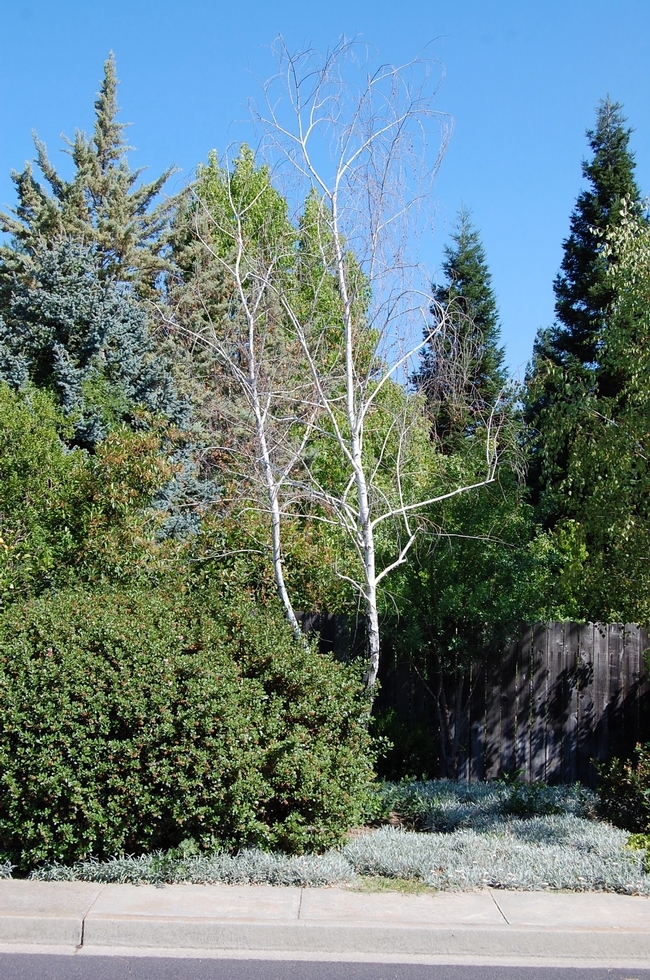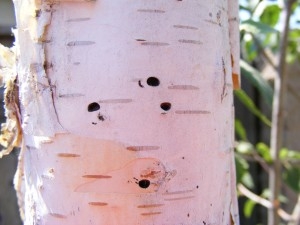Advice for the Home Gardener from the Contra Costa Master Gardeners' Help Desk
Client's Questions and Concerns
Client called with “huge problem with birch trees". She left her email address, but also asked for someone to call and help her with some advice. Called several times but couldn't leave a message since her voicemail box was full. Sent her an email with some of the “usual” problems with birch trees and asked her to contact us if she needed more information. (Note: Although this advice didn't come to satisfactory conclusions, CCMG Help Desk thought it would be beneficial to remind gardeners of the value and care of their trees, especially the oft-planted and vulnerable birch trees, and the need for prioritizing tree care especially during the drought. You can replace and restore many shrubs and perennials in several years and at moderate costs; replacing trees can be expensive when you include value to the property and costs of removal, and can take many years.)
Response and Advice from the CCMG Help Desk
Thank you for calling Master Gardeners with your birch tree problem. However, in order to help you, we will need some more information and either samples or photos of the tree.

photo: Solano County MG
In the meantime, I have included information which might be helpful adapted from an article from a Solano County Master Gardener blog:
- Most likely your birch tree is a European white birch (Betula pendula), native to northern Europe with its cooler climes and plenty of rainfall to sustain the trees. They grow magnificently there, and to their full potential, much larger than any you'll likely see in Contra Costa County.
- In Contra Costa County, especially the central and eastern areas, the life span of a birch tree is approximately 25 years due to heat and lack of rainfall. Decline will often show in branch dieback or leaf drop. During drought, birch trees – which need consistent and deep irrigation – will show signs of stress such as dead branches. Or depending upon the tree's age and care, those dead branches may just be signs of old age and a steady decline.
- Many homeowners with birch don't realize how stressed birch trees can get in drought periods. The natural habitat of birch trees is the forest, where they grow alongside creeks and streams.
- Birch are often planted in lawns and home owners forget that when they stop or reduce irrigating their lawns that birch will often be put in stress unless additional water is provided.
- If your tree is in a lawn, remove the grass from around the trunk out to the drip line and replace it with a layer of fine bark mulch, chopped red cedar bark or aged compost. A bender board around the perimeter of the mulch will prevent the mulch from working into the lawn.
- To determine the actual soil moisture “feeding” your birch, you can push a long screwdriver into the soil, working outward from the trunk to the drip line under the leaves. If the screwdriver does not easily penetrate the soil, then the tree must be irrigated.
- One method of supplemental tree irrigation is to lay several lengths of soaker hoses, working outward from the trunk to the perimeter of the tree under the drip line. Attach a garden hose to the soaker hose and let the water drip for several hours until the screwdriver will easily slip into the soil. You can find a rmuch more duable and automated version of this watering system at http://ccuh.ucdavis.edu/public/drought/tree-ring-irrigation-contraption-tric-1/tree-ring-irrigation-contraption-tric
- The birch root system is also extremely sensitive to fertilizers and herbicides, including weed and feed products as well as mechanical damage, for example string trimmers.
- When birches get stressed during even our “usual” Northern California summer droughts, borers can move in. This problem is often exacerbated by reduced irrigation during our current long-term drought. The bronze birch borer, Agrilus anxius, is the main culprit. Apparently there is quite a large local population of the borers. Intensive insecticide applications may keep them at bay. Check the University of California Statewide Integrated Pest Management website for more information on preventive measures: http://www.ipm.ucdavis.edu/PMG/GARDEN/PLANTS/birch.html.
 Bronze Birch Borer holes
Bronze Birch Borer holes
photo: Vacavilletreeservice.com
If you go to this link and in the right columns scroll down to 'birch borers', you might find clues to what is ailing your tree bug-wise. However, it is important to positively identify the cause before any measures are taken to manage the problem, so we look forward to hearing from you again.
With a little TLC, you should be able to coax a few more years out of your birch.
Contra Costa Master Gardeners' Help Desk
Note: The Contra Costa Master Gardener Help Desk is available year-round to answer your gardening questions. Except for a few holidays, we're open every week, Monday through Thursday for walk-ins from 9:00 am to Noon at 75 Santa Barbara Road, 2d Floor, Pleasant Hill, CA 94523. We can also be reached via telephone: (925) 646-6586, email: ccmg@ucanr.edu, or on the web at http://ccmg.ucanr.edu/Ask_Us/
